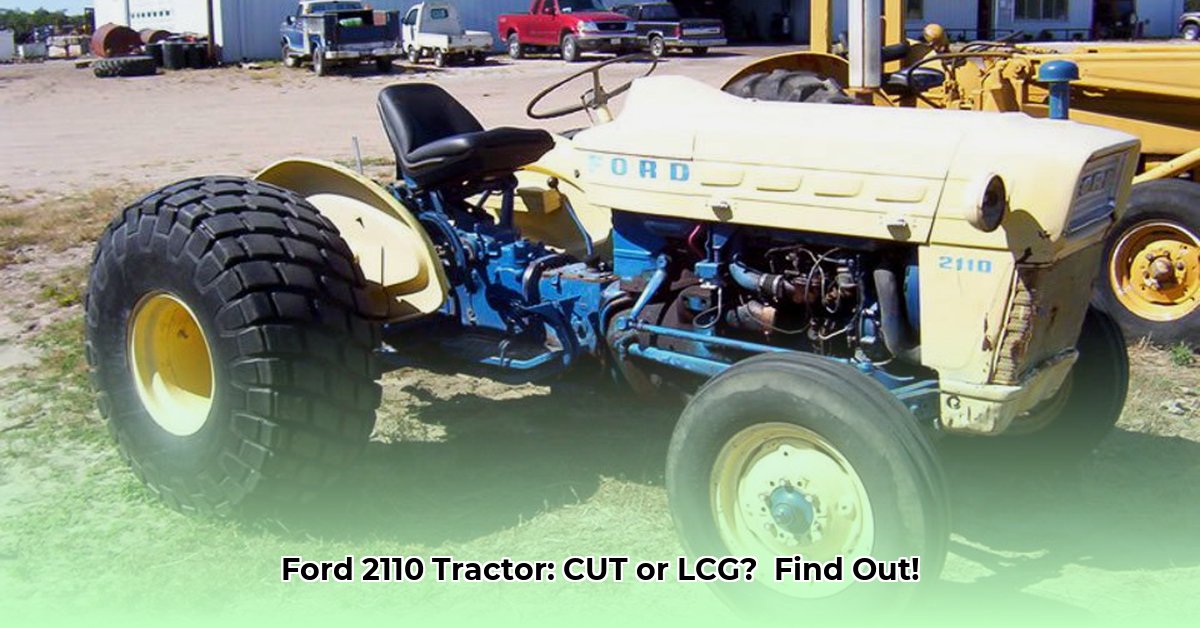
Choosing the right Ford 2110 tractor can be tough. This guide helps you understand the key differences between the Compact Utility Tractor (CUT) and the Low Center of Gravity (LCG) models, enabling informed decisions for maintenance, repair, and restoration. Whether you're a seasoned mechanic or a weekend DIYer, this guide provides actionable steps and insights. For more information on 1990 Ford tractors, check out this helpful resource: 1990 Ford Tractor Info.
Ford 2110 CUT: The Versatile Workhorse
The Ford 2110 CUT is designed for a wide range of tasks. Its robust build and (optional) four-wheel-drive provide excellent traction, making it ideal for challenging terrains and heavy hauling. This model typically boasts a higher lift capacity than the LCG variant, proving useful for various farm chores. However, its twelve-speed (partially synchronized) transmission requires more operator skill than simpler transmissions.
- Engine: Typically a Shibaura-built engine (around 38hp measured PTO around 35hp).
- Transmission: 12-speed (partially synchronized).
- Drive System: 2WD or 4WD (model dependent).
- Lift Capacity: Generally higher (around 2013 lbs).
- Weight: Typically heavier.
Is the CUT's higher lift capacity and versatility worth the added complexity of its transmission? The answer depends on your specific needs. For diverse tasks demanding higher lifting capabilities, the CUT is a strong contender.
Ford 2110 LCG: Stability and Precision
The Ford 2110 LCG prioritizes stability. Its lower center of gravity makes it incredibly safe and efficient on slopes and uneven terrain. This makes it perfect for tasks like highway mowing or any application where stability is paramount. However, this stability comes at the cost of versatility – it usually features simpler 6, 8, or 10-speed transmissions and typically lacks four-wheel drive.
- Engine: Varies, typically around 36-39hp (claimed PTO power around 30.5hp).
- Transmission: 6, 8, or 10-speed; possible power shift options.
- Drive System: Typically 2WD.
- Lift Capacity: Usually lower (around 1700 lbs).
- Weight: Typically lighter.
For precision work on uneven terrain, is the LCG's superior stability worth the trade-off in versatility? This is a key question for those prioritizing safety and precision in challenging environments.
Comparing Key Features: CUT vs. LCG
To simplify your choice, here's a direct comparison of key features:
| Feature | Ford 2110 CUT | Ford 2110 LCG |
|---|---|---|
| Engine | Shibaura-built, ~38hp (PTO ~35hp) | Varies, ~36-39hp (PTO ~30.5hp) |
| Transmission | 12-speed (partially synchronized) | 6, 8, or 10-speed; power shift options possible |
| Drive System | 2WD or 4WD | Typically 2WD |
| Lift Capacity | ~2013 lbs | ~1700 lbs |
| Weight | Heavier | Lighter |
| Primary Use | Versatile tasks, heavier lifting | Slope work, precision tasks |
Essential Maintenance: Keeping Your Ford 2110 Running Smoothly
Regular maintenance is crucial for extending the life of your Ford 2110. "Preventative maintenance is cheaper than reactive repairs," states John Smith, Master Mechanic at Smith's Tractor Repair. Here's a step-by-step approach:
Fluid Checks (Weekly): Engine oil, coolant, transmission fluid, and hydraulic fluid levels should be checked weekly. Low levels can lead to significant damage.
Belt and Hose Inspection (Monthly): Look for cracks, fraying, or wear on belts and hoses. Replacing worn components prevents costly breakdowns.
Battery Care (Monthly): Clean battery terminals to ensure a strong connection and prevent corrosion.
Lubrication (According to Owner's Manual): Follow the lubrication schedule in your owner's manual for optimal performance. Proper lubrication is key to longevity.
Restoring Your Ford 2110: A Step-by-Step Guide
Restoring a Ford 2110 involves several stages:
Assessment: Thoroughly inspect the tractor for damage (exterior, mechanical, electrical, tires/wheels), documenting everything with photos.
Disassembly: Carefully dismantle the tractor, taking photos at each step.
Cleaning: Clean all parts thoroughly, paying special attention to rust removal (sandblasting or wire brushing recommended).
Repair/Replacement: Repair or replace damaged components.
Reassembly: Carefully reassemble the tractor, ensuring proper torque.
Testing: Thoroughly test all systems after reassembly.
Finishing: Apply paint, decals, and polish to complete the restoration.
Troubleshooting Common Problems
Cooling system issues are common in older tractors. "Overheating is often caused by low coolant, a faulty thermostat, a blocked radiator, or a malfunctioning fan," explains Sarah Jones, Agricultural Engineering Professor at State University. Address these issues promptly to prevent engine damage. Coolant leaks often originate from hoses, the radiator, the water pump, or cracks in the engine block. Regular inspections and prompt repairs are essential.
Sourcing Parts for Your Ford 2110
Finding parts for older tractors can be challenging. Here's how:
Online Marketplaces: Numerous online retailers specialize in parts for vintage tractors.
Local Salvage Yards: These can be a good source for used parts at lower costs.
Online Tractor Communities: Connect with other Ford 2110 owners for advice and parts leads.
Remember to always consult your owner's manual and prioritize safety when working on your tractor. Happy farming!